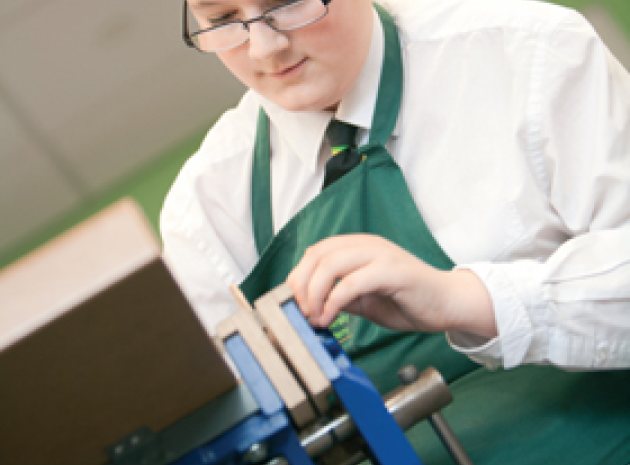Curricula worldwide tend to place emphasis on mathematics, languages, and science, at the expense of design and technology. The new Design & Technology (D&T) curriculum recently launched in UK secondary schools offers a chance to redress this. As Kevin Hewitson of Advocating Creativity in Education (ace-d) says, “The learning experience is much richer as a result of a design approach. Design thinking helps build the bridge between knowledge and understanding because it requires experimentation and application. If we learn to see life as a problem to be solved, then the value of design is clear.”
Design provides students with the skills, attitudes, attributes, and behaviours that significantly improve their ability to learn and manage the environment. Hewitson explains, “Design thinking is the basis on which I have developed the concept of Learning Intelligence (LQ) – the ability of the learner to manage her learning environment to meet her learning needs. Although there is more involved in LQ than just a design approach, the fact that it enables learning makes design thinking an essential part of any school curriculum.”
Hewitson adds, “No matter what changes happen regarding the curriculum, teachers have to deliver a meaningful and relevant curriculum to inspire and develop future design talent.” In other words, it’s up to D&T teachers to be proactive in implementing the curriculum to derive the maximum benefit.
The D&T Association offers training, advice, information, and guidance, but educators need to seek out partnerships with local companies where students can come up with design solutions. Imagine the glow of pride on a student when a design is accepted and produced in the real world!
Addressing the skills gap
The D&T Association also offers a Skills Gap Programme, which links schools with industry in an effort to enhance D&T teachers’ technical skills. The programme equips teachers with ideas on how to make the curriculum exciting, relevant, and applicable to the real world. Delivered over five months, activities are shared between one school and one business and includes a skills check for D&T departments, training and coaching for teachers, a skills project led by teachers, a co-delivery of a project between teachers and employers, and a final assessment for teachers and students.
The aim of the Skills Gap Programme is to focus on technical and soft skills, creativity and innovation, and education and career pathways, as well as making teaching resources accessible to all schools. Some of the businesses involved in this programme are Airbus, Renishaw, and Alucast. Case studies have demonstrated that these collaborations benefit both schools and businesses. Indeed, businesses are grasping the opportunity to enhance their own skills set and utilise their apprentices in coaching teachers and students.
Real world applications
The value of a greater emphasis on D&T in schools is that the skills and innovative thinking developed as part of the curriculum have real world applications. One potential application is a year-end fair where students can gain a taste of the real world acceptance and application of their designs. Here, students can showcase and sell the projects they have designed and created over the academic year. The beginning of the year would be dedicated to researching market appeal and potential projects – perhaps investigating local industries to see what has greatest local appeal. After narrowing down to a particular project, students could begin the design phase. Depending on the size and intricacy of projects, either one piece or a range could be created and sold to the public.
Julie Boyd, trainer, teacher and designer, offers some other tips on implementing the D&T curriculum. She encourages students who have been given a specific assignment to browse shops for examples of the product, and evaluate their composition, ergonomics and appeal. They can then produce a collection of images, together with an analysis, drawings for their own design, and a comparison chart. If students create their own Pinterest, Instagram and Flickr accounts they can assemble collections of solutions to a specific design problem – comparing with others and discussing relative merits.
Sustainability is another important aspect to consider as part of the D&T curriculum. This could even become the primary focus, encouraging students to utilise sustainable resources for materials and to learn the impact their project will have on the environment and local communities. Students could also be encouraged to propose ways to minimise the negative impacts their projects might have and include them in the design.
Practical Action, an international NGO, has many ideas on how to evaluate sustainability. The possibility of teaming up with an NGO like this to devise a design solution would be an exciting venture for students – with the possibility of seeing their design applied internationally.
Fostering creativity
Sir Ken Robinson, PhD, author and educator, has been challenging the way we educate our children for years. He has called for arts – including D&T – to be on an equal footing with other subjects, with his focus being on cultivating creativity and acknowledging that there are multiple types of intelligence, with D&T skills being one such type of intelligence.
In appreciation of arts subjects, three institutions – the Organization of American States (OAS), the Inter-American Development Bank (IDB), and the British Council – combined their resources to demonstrate the importance of creative and cultural activities to global growth. Together they presented the study, “The Economic Impact of the Creative Industries in the Americas” in Santiago, Chile, at the International Federation of Arts Councils and Culture Agencies’ (IFACCA) sixth World Summit on Arts and Culture. According to data compiled by Oxford Economics, creative goods and services, including D&T, generated approximately £400 billion in exports in 2011.
As technology changes, educators need to encourage divergent and creative thinking in order to keep up with the design challenges faced in a global market where sustainability is key. The new D&T curriculum provides an apt opportunity to achieve this.
Case Study Skills
Ofsted has published case studies demonstrating good practice in D&T. As an example, Ripley St Thomas Church of England High School incorporated computer-aided design and manufacture (CAD/CAM) into its D&T curriculum, enabling students to use professional standard software and manufacturing equipment. By the time students were ready to enter the working world, they had a good knowledge of the systems used, which placed them significantly ahead of other students.
Case Study Production
Gabrielle Forster-Still, Deputy Head of Royal Opera House Learning and Participation, Thurrock, says, “Inspiration Days at the Royal Opera House Bob and Tamar Manoukian Production Workshop in Purfleet are a fantastic way to engage students. The day is a perfect way for students to find out more about all areas of the backstage work from set design, costume, props, special effects, make-up, puppetry and millinery, and to teach them about the various possibilities of careers in the creative industries.”
Forster-Still elaborates, “This is the fifth year of the Royal Opera House’s Design Challenge, which works with students from Creative and Cultural Skills Academy Colleges on a real brief – this year, the opera Madame Butterfly. The challenge is for them to work on set, costume or wigs and make-up designs, or to produce a marketing strategy for the whole production. This is the first year we have also worked with secondary school students on this project, allowing them to find out about other careers in D&T and inform their choices.”
Case Study Sustainability
Heath Nash is a South African designer who started making lights from recycled plastic bottles. His lights attained worldwide acclaim, netting him an international clientele. Apparently, it all started with learning the art of origami as a youngster!
About The Author
Nicola Davies is a psychologist and freelance writer with a passion for education. You can follow her on Twitter (@healthpsychuk) or sign up to her free blog: http://healthpsychologyconsultancy.wordpress.com/








